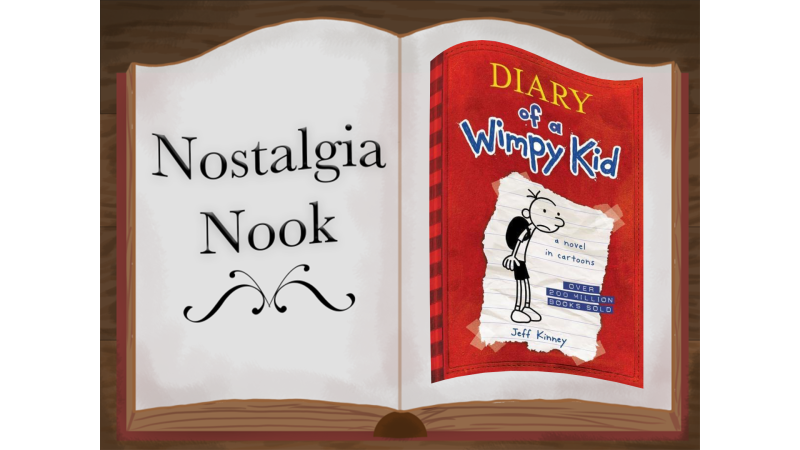Welcome to“Nostalgia Nook”! In this column, I revisit popular children’s literature from the early 2010’s. I’ll discuss the book’s highlights, examine the culture that developed around the book, and check in on where the books are now. I hope that I’ll be able to remind you of iconic books, forgotten moments and re-spark your love for children’s literature.
“I’ll be rich and famous one day, but for now I’m stuck in middle school with a bunch of morons,” writes Greg Heffley, the protagonist of “Diary of a Wimpy Kid.”
“Diary of a Wimpy Kid,” written by Jeff Kinney, was first published in 2007. The series follows Greg Heffley, his family and his best friend Rowley Jefferson on their daily misadventures navigating life at school and home. As the title indicates, the series is told through Greg’s diary, with most entries accompanied by ‘Greg’s’ doodles. Since 2007, the first book has sold over 275 million copies, with 16 more books being published in the series. Kinney has also created a spin-off series, “Awesome Friendly Kid,” which follows Rowley. The series has also been adapted into several movies and a musical.
“Diary of a Wimpy Kid” was a defining cultural moment for most people my age. Kinney was never afraid to include some of the more uncomfortable, awkward and painful parts of growing up in his books, and always managed to find the humor in these moments. To me at least, it often felt like Kinney was one of the only authors who really got what it felt like to be a kid. The success of these elements reflects in the success of the series as a whole.
Greg is something of an unlikely hero. He is awkward, untalented and selfish — in short, a much more relatable protagonist than those of the other books popular at the time. Despite his flaws, it was always incredibly entertaining to see the world through his eyes and humorous voice. Each of the characters in the series is equally flawed, in their own humorous and quirky ways. My favorite character was always Manny, Greg’s younger brother, who has an incredible feral energy. The “Diary of a Wimpy Kid” fan wiki describes Manny’s relationship to the Heffley family perfectly: “Greg believes that his, Rodrick‘s, and Manny’s parents treat Manny like a prince, but that is far from the truth as they treat him this way out of fear of what he will do to them.”
In elementary and middle school, “Diary of a Wimpy Kid” was everywhere. Every school book fair proudly featured copies of the newest “Diary of a Wimpy Kid” book. On the playground, kids recycled jokes from the books, or brought out the dreaded “Cheese Touch.” And everyone (me NOT included), inexplicably had a crush on Rodrick, Greg’s older brother.
It was one evening in my dormitory that a friend told me the information that would change my life: “Did you know that Jeff Kinney — the guy who wrote ‘Diary of a Wimpy Kid’ — created ‘Poptropica’?”
I was stunned. Was this common knowledge? Had everyone else been walking around knowing that Jeff Kinney, the creator of “Diary of a Wimpy Kid,” was also the creator of “Poptropica”?
Some may call “Poptropica” a video game or an interactive story. Some may call it Jeff Kinney’s greatest creation, or even the most defining cultural movement for the late 2000s and early 2010s. “Poptropica” is not merely a game. “Poptropica” is an unstoppable cultural phenomena disguised as a children’s online game. Created by Jeff Kinney in 2007, the game allows players to explore various islands and complete quests. Each island has a different theme, with every aspect of the island, from characters to settings, designed to match said theme.
I recently logged back into the website to see if the game still holds up. I opened the website with the intention of playing for 15 minutes when I discovered what every middle-schooler knows: one does not simply play “Poptropica” for 15 minutes — dad, just five more minutes, please! The next thing I knew it had been 2 hours. The storylines are incredibly enthralling and the interactive elements are equally entertaining. Kinney’s signature brand of humor shines through, and all these elements combine to make for some rather addictive gameplay.
When I logged onto the website, I was unable to rest until I had completed my run through of Fairy Tale Island. On Fairy Tale Island, the player must interact with non-player characters (NPCs), such as Snow White, Cinderella and Red Riding Hood, in order to restore their happy endings. “Poptropica” irreverently reimagines these stories in a fresh, humorous light. For example, Cinderella finds her happy ending after giving a rock music performance. I also had a great time accessorizing my character in a fairy tale dress and giving her a pet lizard that follows her around.
With each distinct island comes its own unique challenges and difficulty level. As a kid, Mythology island was the bane of my existence. Theme-wise, it was one of my favorite islands. Difficulty level-wise, I hated it. My little sibling and I spent hours and the computer trying to figure out how to complete it.
Both “Diary of a Wimpy Kid” and “Poptropica” thrive from their use of humor and fun storylines. Looking back, it seems obvious that the two properties were made by the same creator. “Poptropica,” like “Diary of a Wimpy Kid,” is unafraid to lead into the more humorous and uncomfortable aspects of the story. When I was doing my run-through of Fairy Tale island, both Snow White’s prince ugly-crying and the horse that would vomit whenever interacted with felt very Kinney-esque. “Diary of a Wimpy Kid” and “Poptropica” are both iconic properties, defining the culture of a generation. The power of Jeff Kinney’s storytelling is unstoppable.
